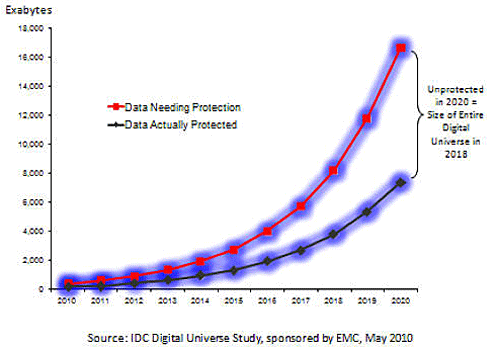The digital universe is expanding at a more rapid rate than IT organizations can manage.
That’s the basic conclusion of the annual Digital Universe forecast delivered by IDC on behalf of EMC.
Probably no one would take issue with projections that call for the overall digital universe to grow to 35 zettabytes, where each zettabyte equals a million petabytes. And just for the record, a petabyte is a million gigabytes.
According to Chuck Hollis, global marketing CTO for EMC, this kind of growth will require some fundamental changes to the underlying technologies to access that information and the way IT organizations approach mangement of it. On the technology side, Hollis said existing file systems and databases were never designed to handle systems that might soon contain trillions of records. As a result, we’re already seeing the rise of object-based storage systems and data-management frameworks such as Hadoop. As data proliferates, these types of technologies will find mainstream adoption as IT organization look to contain costs, he said.
But even with new technologies, Hollis said many IT organizations will be so overwhelmed that they inevitably will rely more on external data-management services. In fact, Hollis argues that IT organizations already are rethinking their approach to data management using concepts generally referred to as delivering IT-as-a-service with many moving data to a cloud provider or contracting for management of their on-premise data. That means more data-management functions are automated in a way that requires fewer IT specialists, but that dedicates people to managing the flow of information across the enterprise, he said.
Hollis added that some form of convergence in the data center also is inevitable to effectively manage IT-as-a-service. For example, he expects more customers to adopt IT system architectures similar to Vblock, a set of pre-configured systems that come with servers from Cisco, VMware virtualization software and storage from EMC integrated in a way that doesn’t require dedicated storage, server and networking specialists to manage them.
Of course, that may not be popular with the internal IT staff, but the economics of that approach almost makes its mainstream adoption a foregone conclusion, he said.
It's clear we’re on the cusp of a major transformation in the way IT systems are managed. Exactly how that transformation will manifest itself remains less clear, but it most certainly won’t look like anything we have in place today.
Click through to see findings of the survey conducted by EMC/IDC.
The digital universe will be 44 times bigger than it was in 2009.
15 percent of the data in the digital universe will reside in the cloud by 2020.
By 2020 about 50 percent of the information in the digital universe will require IT security.
But the actual amount of information that needs to be protected is closer to 90 percent.
The amount information being created is rapidly outpacing the available storage space.
The amount of user-created information that IT will need to manage is growing rapidly.
Use is growing, but policy guidelines are trailing.
Spending on IT storage willgrow onlymodestly through 2020 on a current base of $4 trillion a year.
As the cost per GB drops, so do investments in IT staff.












